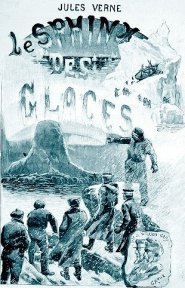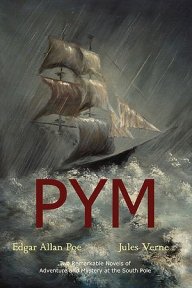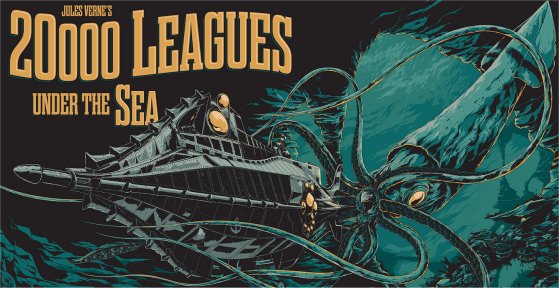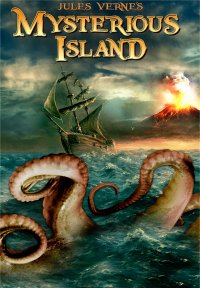
Official Edgar Rice Burroughs Tribute and Weekly Webzine Site
Since 1996 ~ Over 1,000 Web Pages in Archive
Presents
Volume 5018
Antarctica and Mars in Early Genre Fiction
By Jeff Deischer
Copyright 2009 by Jeff Deischer: ikonoklast61@juno.com
Part I: Antarctica
(Continued in Part II: Mars) Antarctica in early genre fiction is much different than in reality, owing to authors filling in the blanks, so to speak, before the continent was explored. Surprisingly, there is, in fact, some similarity between the descriptions of Antarctica in the accounts I have studied (which may by no means be all that there are; they are simply the ones of which I am aware. I did not purposely pick and choose stories to fit my theories). Whether this is coincidence or not is uncertain, but we know that Jules Verne’s The Sphinx of the Ice Fields (AKA An Antarctic Mystery), for example, was written as a sequel to Edgar Allan Poe's The Narrative of Arthur Gordon Pym of Nantucket.
Antarctica in early genre fiction is much different than in reality, owing to authors filling in the blanks, so to speak, before the continent was explored. Surprisingly, there is, in fact, some similarity between the descriptions of Antarctica in the accounts I have studied (which may by no means be all that there are; they are simply the ones of which I am aware. I did not purposely pick and choose stories to fit my theories). Whether this is coincidence or not is uncertain, but we know that Jules Verne’s The Sphinx of the Ice Fields (AKA An Antarctic Mystery), for example, was written as a sequel to Edgar Allan Poe's The Narrative of Arthur Gordon Pym of Nantucket.It is in this latter story (first published in 1837) that Antarctica probably first appears in fiction, at least what we think of as modern popular fiction. Pym, the narrator, leaves Nantucket in June, 1827, and after a number of tribulations, arrives near Antarctica on January 17, 1828, as an erstwhile member of the crew of the Jane Guy, a schooner (CH 17); he and Dirk Peters are the only survivors of the whaler that they had left Nantucket on (Pym as a stowaway), and were rescued by the Jane Guy. On this date, a small island is discovered at 82o 21' S, 42o 20' W. The captain of the Jane Guy (himself named Guy) names this Bennet’s Islet, after his business partner. They have, by this time, left ice behind (CH 17); Pym later writes that he never saw ice south of Bennet's Islet (CH 25), suggesting that the south pole is surrounded by a ring of ice north of 83o S.
The Jane Guy continues south, where, at 83o 20' S, 43o 5' W, a group of very large islands is spotted (CH 18) (these are located in the present-day Weddell Sea). These are inhabited by jet black-skinned natives who are as tall as “Europeans”, but are stockier and more muscular. Initially befriended by the natives, the crew of the Jane Guy is later killed when they make ready to depart on “the first of February” (CH 20), 1828. Only Pym and Peters escape this fate, by accident (CH 21). After several days of hiding and exploring, they steal a canoe and head southeast, to avoid the natives (CH 23-25), and come upon land on “March 22” (CH 25). The water is too hot to touch in this area, apparently due to an active volcano that is shrouded in “vapour”; ash has rained down continuously for two weeks prior to landfall, or near landfall: their canoe is being driven by a powerful current towards a chasm when the narrative ends – with Pym spotting a snow white-skinned giant.
A “Note” by the publisher ends the narrative, explaining that Pym died (in circumstances known to the public) without relaying the final “two or three chapters”. Pym himself begins the narrative, the Preface of which is dated “July, 1838”, by revealing that the manuscript was written “a few months” ago, after his return to the U.S., where he was persuaded by a number of men in Richmond, Virginia (one of whom was Poe), to publish the account. The publisher and Peters speculate, in the end-of-story “Note”, that the chasms on Tsalal, the largest of the black-skinned natives’ islands, are parts of a language, forming words in Ethiopian, Arabic and Egyptian. The publisher concludes that these words mean that the land of the natives is called “black” (more or less), and that the “region of the south” is called “white”, indicating that it is the land of white-skinned natives, apparently giants. The black-skinned natives seemingly know of the white-skinned natives (though they appear to be too primitive to have carved the chasms), and apparently fear them; they in fact fear anything white, and the only explanation would seem to be because this fear is based on the white-skinned giants. What occurred after the end of Chapter 25 is never revealed (at least by Poe); we only know that Pym and Peters made it back to civilization, though the narrative would have likely ended with the pair sighting a ship.
Pym’s account indicates that there is no ice between the black-skinned natives’ islands and the South Pole, for he and Peters (and the native that they captured, named Nu-Nu) would seem to have traveled two thousand miles in the canoe, based on Pym’s data. This seems impossible, as it is only a thousand miles to the pole from the islands. The breeze that blew the canoe (Pym and Peters rig a sail) must have been very mild, and the current not as strong as Pym suggests and the canoe wasn’t in it for as long as Pym says. According to Pym, he and his companions sailed for thirty days. It also seems impossible that the two men could have stored enough food for such a long voyage. Pym himself admits (CH 25) that he is only approximating the date (and therefore the passage of time).
(As an aside, I have to wonder if Dirk Peters is related to Monk Mayfair, Doc Savage’s ape-like aide, on the latter’s father’s side (because it is the Mayfairs who are homely, and one is virtually identical to Monk, also indicating that the simian build is a Mayfair trait). Peters is half Indian (his mother was a “squaw”). His arms and legs are bowed. He stands only 4'8" but has “Herculean” strength (CH 4). In The Sphinx of the Ice Fields, “ten [men] strove to control the half-breed” (CH 22), attesting to this strength. A character in A Strange Discovery calls him an “orang-outang” (CH 13) and he breaks the spine of a man with his bare hands. Peters was born near the turn of the century (The Sphinx of the Ice Fields says 1896), putting three generations between him and Monk. He could therefore be Monk Mayfair’s great-great uncle.)
Fifty years later, a sequel to Poe’s The Narrative of Arthur Gordon Pym of Nantucket appeared. In fact, there were two of them, the first of them written by the illustrious Jules Verne. In his The Sphinx of the Ice Fields (1897), the narrator is an American geologist named Joerling (CH 1). On “the 27th of August” 1839 (considering later dates given, this must surely be a typo for August “7th”), the schooner Halbrane arrives at the Kerguelen Islands, where Joerling has been for about two months. The Halbrane is captained by Len Guy, the brother of the captain of the Jane Guy (only called the Jane herein), from The Narrative of Arthur Gordon Pym of Nantucket, though this is not revealed for some time (CH 6). Like many readers, Joerling believes that Poe’s tale was entirely fictional, and that the two names are a coincidence. Len Guy reveals that he found a bottle with a letter from his brother on one of the Kerguelen Islands, and he believes some of the crew of the Jane Guy might still be alive (CH 4). While on their way to Tristan d’Acunha, Patterson, a survivor of the Jane Guy, is found on an ice block, confirming Len Guy’s theory – or, rather his corpse is. Patterson’s body has a short journal on it, stating that there are five other survivors on Tsalal, which he had left “the 3rd of June” (CH 6).
“On the 15th of October”, the Halbrane arrives at the Falkland Islands to take on supplies and additional crew for an expedition to find the survivors of the Jane Guy. One of these is a man named Hunt, who keeps to himself (CH 9). On Christmas Day, the Halbrane arrives at Tsalal, where they find many skeletons, many years old; they therefore cannot be those of the survivors of the Jane Guy, who were alive only months ago, according to Patterson’s journal (CH 16). Joerling believes that an earthquake struck the island, forcing the survivors of the Jane Guy to another island. They find evidence (CH 17) that in fact an earthquake had sunk all of the islands in the Tsalal group, except for Tsalal itself.
The crew of the Halbrane also finds the collar of Pym’s dog Tiger on Tsalal (CH 16). Joerling believes that Tiger came to Tsalal with Pym, although this isn’t described in Pym’s narrative. This turns out to be correct, and is in fact necessary to Verne’s story: Tiger infected many of the black-skinned natives of Tsalal with rabies (CH 24). But this means that the survivors of the Grampus killed and ate a man – Parker – while Pym’s dog was still alive!
The next day, Hunt reveals that he knew Peters in Illinois, and Peters told him that it was he, and not Pym, who arranged to have the narrative published; Pym did not return from Antarctica (CH 17). Peters happened to have Pym’s notes on him when he was taken away on an ice block while Pym unwillingly continued south in the Tsalal boat. When Peters returned to Tsalal, he found it deserted. He then made his way back to America, and Illinois, where he met Hunt – who reveals that he is in fact Peters himself. He spent “nine years” in Illinois, and then went to the Falklands, where he had been for “over two years” (since early 1837, then), in hopes of returning to the Antarctic to find Pym. He later (CH 18) reveals to Joerling that Pym changed the name of Parker, the man killed and eaten, in order to protect his family. His real name was Ned Holt – and he was the brother of Martin Holt, one of the crew of the Halbrane.
Continuing south over the protests of the new men taken aboard at the Falklands (particularly one named Hearne), they sight land on January 17, 1840 at about 88o 55' south, 39o 12' west. The continent of Antarctica, as it turns out, is in fact two continents, with a wide channel separating them (CH 20-21). The Halbrane is struck by an iceberg on the following day, and hoisted aloft as the iceberg tilts (CH 19), and is then grounded itself. For many days, the crew tries to free the ship, and do so on January 29 – destroying the Halbrane in the process. The following day, the iceberg is knocked loose by another iceberg, and they begin drifting towards the south pole (CH 20), where, not far from the pole itself lies a narrow strait only 10-15 miles wide. They name this the Jane Strait, after the ship that they are seeking (CH 20-21).
After passing the south pole, the iceberg runs aground on February 6, at 86o 12' south, 114o 17' east (CH 21). On the “7th of February”, Hearne leads a mutiny, stealing the Halbrane’s boat, stranding several men, which includes Len Guy, Joerling and Peters (CH 22). Preparing to spend the winter there, the castaways name their new home Halbrane Land after their ship. On “the 19th”, the castaways spot a small boat – which carries the remaining survivors of the Jane Guy (CH 23) (two had died on the voyage south), which brings the total survivor number to an unlucky thirteen. They confirm Joerling’s deductions about what had happened on Tsalal, and “on the 21st of February”, the entire group sets out in the boat, which they name Paracuta after a local fish (CH 24).
On March 12, the boat arrives at 75o 13' south, 118o 3' east, where the survivors see a “sphinx” not far from shore. This is a natural formation that only vaguely resembles the Sphinx in Egypt, and is a lodestone “thousand of cubic yards” in volume; Joerling believes it sits at the south magnetic pole (it does not). All of their iron implements on the boat are drawn towards the sphinx, which they decide to investigate. Upon the shore, they find the boat that Hearne and the mutineers had stolen, and three corpses; ten men – or bodies, the castaways believe – are missing. At the sphinx, they find the corpse of Pym, who was trapped against the giant lodestone by his iron musket harness. Peters, upon seeing Pym’s body, drops dead (CH 25).
Continuing north, the survivors spot the three-master ship Tasman “on the 6th of April” and are taken to Melbourne, Australia, arriving “fifteen days” later (CH 25), ending the novel.
Charles Romyn Dake’s A Strange Discovery (1898) is a first-person narrative written in 1898 by an unnamed Englishman who visited the United States in “1877”, at which time he met an aged Dirk Peters. The further adventures of Pym and Peters don’t really begin until Chapter 10 (about halfway through the story), after Dr. Bainbridge, an erudite man, has had “two days’ and nights’ experience” listening to Peters reveal what happened to the two men after the end of The Narrative of Arthur Gordon Pym of Nantucket. He then begins to relate this to the narrator: the white “curtain” seen by Peters and Pym was in fact a wall of mist; the white giant, a statue. The two are met by inhabitants of the island kingdom of Hili-li, which was founded by Roman colonists a “thousand years” ago (CH 11); the main island is located at 75o east (CH 10) and three hundred miles from the nearest “mainland” (apparently Africa’s Cape of Good Hope, though this distance seems off by hundreds of miles, given other information about the polar region in this story) (CH 16). Each citizen undergoes continual education, so that he (or she) doesn’t stagnate and they stay vital even into their eighties. Criminals are banished (CH 11) to a ring of mountains (CH 16) surrounding a central volcanic crater on an island (CH 17) that lies very near the south pole (CH 10) and provides heat and light for the main island (CH 12). This ring of mountains, simply called “The Mountain” by the Hili-lites (CH 17), is the Antarctic continent (CH 16). It lies within a twelve hundred diameter sea that has only two entrances, one the three hundred mile opening used by Pym and Peters, and another, smaller one on the other side of the ring that is usually frozen over (CH 16). The land on the other side of the crater – in the direction of the present-day Ross Ice Shelf – is below freezing (CH 13). Outside of this ring of mountains lies a “zone of islands” – two to three hundred in number -- which extends up to seven hundred miles (CH 12).
“Five hundred years before” (CH 18), invaders came from Southern Europe (CH 11), and, suffering devastating losses, were defeated. As punishment, they were forced to dye their skins black, the opposite of Hili-li’s national color, white (CH 12) – explaining Poe’s black-skinned natives. This process must be repeated every five years.
On Hili-li, Pym falls in love with Lilama, who is kidnapped three months later (in late July) by one of the exiles who was in love with her (CH 12). A small party (which includes Pym and Peters) goes after her, sailing to “Volcano Bay”, the opening of which is thirty miles from Hili-li Island (CH 13), and abuts “Crater Lake” (CH 14) after winding passages through the mountains, one of which is named “Mount Olympus”, due to its eight-mile height (CH 13); the criminals are derisively referred to “Olympians” because of this (CH 16). There, Lilama is rescued by Peters (CH 14). “Not many weeks after the rescue”, Pym and Lilama are married (CH 16); this occurs before “December” (CH 17).
“In the night between February 16th and 17th” (1829), a once-in-a-century snowstorm that is part hurricane and part blizzard hits Hili-li (CH 18). As Pym, Peters and four hundred exiles who are in the process of being pardoned try to get the citizens to safety, Lilama freezes to death while trying to help one of her old nurses (CH 19-20).
Pym, inconsolable over the death of his wife, and Peters leave Hili-li in December 1829, and part ways in Montevideo, Uruguay in February 1830. This is the last that Peters saw of Pym, with Pym heading to America and Peters planning to accompany a fellow sailor to Australia (CH 20). After hearing the end of the tale from Bainbridge, the narrator returns to England (CH 20).
It should be immediately obvious that the two sequels to Poe’s tale are mutually exclusive; both cannot be true. Of course, the most obvious and most difficult-to-overcome difference is that Peters survives in one account and is killed in the other, setting aside all other differences for the moment (even that of Pym sharing a similar dissimilar fate). Peters cannot have died in Verne’s tale to tell his story decades later in Dake’s. So which is true, i.e., canonical?
Certainly, the Dirk Peters of A Strange Discovery could be an imposter. Every word of his tale could be false. But what is his motive? He is not going around bragging that he is Peters, gaining either fame or fortune by his tale. The author of the story finds him quite by accident. The point is made in the story that none of the medication that old “Peters” takes causes hallucinations or delusions. So it seems highly unlikely that this man is either lying or mistaken. If we accept A Strange Discovery as canonical, then this man is Dirk Peters and he is telling the truth about what happened to him after The Narrative of Arthur Gordon Pym of Nantucket.
What about The Sphinx of the Ice Fields? Well, Verne happily threw out the parts of Poe’s story that interfered with his own. For example, he added the bottle left on one of the Kerguelen Islands for Len Guy to find; he ignored both the ash and the white giant at the end of Poe’s story; Peters, bald in The Narrative of Arthur Gordon Pym of Nantucket, has hair. While Peters might be wearing a wig at this time (as he sometimes did in Poe’s tale), his wig is an obvious false hairpiece; no one in The Sphinx of the Ice Fields notices this, if true. So while Verne’s story is a tale more excitingly told, Dake’s, related secondhand, at least remains completely faithful to Poe’s story, in detail if not in theme (it is less adventure than romance). And his Antarctica is no harder to believe than Verne’s; in fact the two can fit together, with a little work.
As noted, the biggest stumbling block between the two stories is the fate of Peters. If we accept Dake’s tale as canonical, we must throw out Verne’s. Or must we?
I wonder if Verne’s “Hunt” is indeed Peters? Could his back story be true – that he met Peters in Illinois? But instead of accompanying him to the Falkland Islands, journeyed there alone, with the hopes of exploring the Antarctic himself?
No, too much of Verne’s story hinges on Hunt being Peters: his unwavering resolve to find Pym, his earlier cannibalism secret contributing to the success of Hearne’s mutiny, etc. So I think that Hunt must indeed be Peters – assuming The Sphinx of the Ice Fields is authentic. It seems less so than A Strange Discovery.
It seems a shame to discard either story. It is possible to reconcile the two in some other way, accepting that Peters appears in both stories? The question, I think, is not only is either of them canonical, but are all parts of either canonical?
Is it possible that much of both tales is true? Could Pym and Peters have had the adventures attributed to them by Dake prior to Peters returning to America, as he related to Len Guy and Joerling in Verne’s story? This would mean that Peters left out a large part of what had happened to him and Pym. Considering his reticence on other topics, this at least seems possible.
Specifically, the death of Peters in The Sphinx of the Ice Fields seems to be a case of poetic license. Not only is it convenient – Peters dies upon fulfilling his quest of locating Pym – but mention is made of the “unlucky thirteen” survivors. Apparently Peters was the unlucky thirteenth. Also, Peters does not seem to be the type to die in the manner that he does. And we already know that Verne plays it fast and loose with his “facts”: consider the case of the two Captain Nemos. The first dies at the end of Twenty Thousand Leagues Under the Sea only to reappear in The Mysterious Island without explanation (the latter story also contradicts the dates of the former without explanation). So it is not difficult for me to believe that Verne falsely killed off Peters for dramatic effect. No doubt Peters withheld information about the Hili-li, in gratitude for their treatment of him.
But what about Peters’ motive in The Sphinx of the Ice Fields – wanting to search for the long-lost Pym? If he knew Pym had returned to America in A Strange Discovery, then how could he be determined to search Antarctica for him? This is the lynchpin of the case against Peters dying in The Sphinx of the Ice Fields: if Peters believed Pym had been in Antarctica since 1828, why did he wait eleven years to search for him, as he claims in Verne’s story? This just doesn’t ring true, and is better explained if Peters had only recently – in 1839 – learned that Pym had returned to Antarctica. Probably, Pym had told his old friend of his intention to do so some years earlier, and Peters, not hearing from Pym for some time in 1837 (the year Peters went to the Falklands, according to Peters, if we are to believe Verne), went to the Falkland Islands to begin a search for him. There, he joined Len Guy’s crew in 1839. This of course ignores the fact that Pym wrote the Preface to his narrative in July 1838. I think he must have returned to Antarctica shortly after writing it, and never finished the manuscript itself. Peters soon followed him – we know he was in the Falklands by mid 1839 – and perhaps Verne played up the “poor Pym” angle to an unwarranted degree – again, for dramatic effect. With the matter of the activities of Pym and Peters after their initial journey to Antarctica out of the way, what about the geographies of the two stories?
The survivors of the Halbrane in The Sphinx of the Ice Fields could easily have mistaken the ice-laden islands of A Strange Discovery for the shores of the channel that both authors say transverses the antarctic region. It is a matter of width, not land mass.
Both versions of Peters seem to believe that they have reached the south pole – or at least Joerling and/or Len Guy thought so in The Sphinx of the Ice Fields. We must take the captain’s calculations as correct, I think, meaning that Peters is mistaken in A Strange Discovery. This is not too great an error; he in fact states that crater may be a few miles away from the pole, and Len Guy never explicitly states that his group sailed over the pole, either. Given the temperature difference near the pole in the two voyages (Pym’s and the crew of the Halbrane’s) and the fact that Verne’s group did not meet the Hili-lites, I believe the iceberg in The Sphinx of the Ice Fields must have travelled north of the central volcanic crater. The distance between the crater and open water to the north could be as little as twenty miles, meaning that both could be close to the south pole. So these two versions of Antarctica mesh fairly well, if not perfectly.
H. P. Lovecraft attempted his own sequel, of sorts, to The Narrative of Arthur Gordon Pym of Nantucket in At the Mountains of Madness (1936). While the story doesn’t deal with Pym, it takes place on the Antarctica of Pym. William Dyer, the narrator, mentions Poe’s story, and the sound “tekeli-li” from The Narrative of Arthur Gordon Pym of Nantucket is heard here; the gray mists seen by Pym are seen by Dyer, as well. These come from two cones (CH 2), but are not believed to be “volcanic” (CH 12).
Dyer is the geologist (CH 1) of an expedition to the south polar continent, one of two survivors in the end (CH 3). Leaving Boston on September 2, 1930, the expedition makes landfall on the continent on November “the 9th” and sets up base camp. Lake, the expedition’s biologist, begins exploring the area to the northwest on January 11, and on January 23, finds a cave that leads to a vast cavern (CH 2). Lake’s party becomes incommunicado, and the next day, Dyer and his party investigate, then leave the continent after finding Lake’s camp destroyed and the party members dead (CH 3). The remaining chapters (4-12) detail the exploration by Dyer and Danforth (the other survivor, who is driven insane by what he sees) of the city of the Old Ones, during that day of investigating what happened to Lake’s party.
As we might expect, it is not too difficult to reconcile the Antarctica of Poe with that of Lovecraft, either geophysically and thematically. Lovecraft admitted that he wanted to achieve the same effect that Poe had one hundred years earlier. His story virtually picks up where Poe’s left off, with regards to Antarctica: much of Poe’s story concerns Pym’s adventures prior to his arrival in the Antarctic, and it is only at the very end of his tale that he actually arrives at the continent. By contrast, very little of Lovecraft’s story takes place before the expedition’s arrival upon the continent; nearly all of it centers on the expedition’s time on Antarctica. Lovecraft describes the opposite side of Antarctica (100o E) that Poe did (40o W), so that his Antarctica does not contradict Poe’s version greatly (Lovecraft used more up to date information about Antarctica than Poe did, of course, resulting in minor differences).
The gigantic mountain range that Lovecraft describes seems to abut the entrance of the channel Poe describes, and circles around the eastern part of Antarctica, roughly following the 80th parallel until about 60o E, where it loops out towards the coastline, ending in low hills at about 140o E, apparently (these were seen by the earlier explorer Wilkes, after whom the area is named today). Dyer only gives specific coordinates for the area of the highest peaks, which start at about where the range begins its gentle curve towards the coast, to about 110o E. To the west, in the direction of Victoria Land and the Ross Ice Shelf (where landfall was made), lies the plateau Leng, not more than three hundred miles distant from these highest peaks, and beyond that, the base camp (at 86o 7' S, 174o 23' E). Even further, at the coast, lay the two ships that brought the expedition’s gear and team members, the Arkham and the Miskatonic.
While Poe’s and Lovecraft’s Antarcticas fit together well enough, the same cannot be said about Lovecraft’s and the Antarctic of either sequel: Lovecraft paid no attention to the sequels, if he was aware of them. The great “Mountains of Madness” do not appear in either sequel (though this is less clear in Verne’s account than Dake’s), and the survivors of the Halbrane cross the Leng plateau via the afore-described channel that transverses the polar region. Verne’s channel – according to his map; its description in the novel is fairly vague, with coordinates along the way given only rarely-- runs from about 40o W (where Pym arrived at the coast), roughly straight through the “continent”, and exiting at about 90o E.
The Mountains of Madness must be a range undescribed in Dake’s story, which does not invalidate either account; they rise out of Dake’s inland sea, far to the east of the Hili-li Kingdom. One change from our common Antarctica is that the narrow mouth of the wide channel must curve towards 150o east, in order to accommodate Lovecraft’s mountains, which are not present – or at least not described – in either sequel.
And Lovecraft’s Antarctica has no inland sea, apparently; Dyer flies over the South Pole on “January 6, 1931”, but he makes no mention of anything unusual there. It would therefore seem, that if the details of each narrative are generally authentic, then the south polar sea has frozen over by the time of At the Mountains of Madness. But more on this later.
The inclusion of At the Mountains of Madness brings in a number of Lovecraft tales into our “common” Antarctica. The alien beings and places Dyer mentions are referenced in a dozen or more other Lovecraft stories; Dyer’s first name is in fact given not here, but in “The Shadow Out of Time”. Likewise, Leng’s full name, Y’Pawfrm e’din Leng, is given elsewhere (“Celephais”). The Shoggoths are mentioned in no less than three other Lovecraft stories.
(On a side note, I have to wonder if the “thing” in John W. Campbell’s “Who Goes There?” (1938; later filmed as both “The Thing From Another World” and “The Thing”) wasn’t in fact one of Lovecraft’s Shoggoths, which were able to change shape, according to Dyer’s account. We don’t know what the “thing” looked like in its natural form and we can’t be sure from Dyer’s limited deductions that the Shoggoths, some of which (whom?) were adapted to land living, weren’t also able to consume a living thing to assume its form. This hypothesis would, of course, discount finding the “thing” in a spacecraft, since the Shoggoths were created on Earth, and the Old Ones themselves came to Earth without the use of vehicles.)
There is one final facet of Antarctica we must examine, one that takes us to ... Mars. . . . Continued in Part II
JEFF DEISCHER
ikonoklast61@juno.comJeff Deischer is a Marvel Comics Silver Age and Doc Savage scholar who has a passion for chronology. Among his non-fiction works are The Way They Were: the Histories of Some of Adventure Fiction's Most Famous Heroes and Villains (which contains the above essay), The Marvel Timeline Project, Part 1 and The Adventures of the Man of Bronze: a Definitive Chronology.He has also written a number of novels, including the pulp superhero series THE GOLDEN AGE, of which five volumes have been published thus far.
Suggested reading
The Sphinx of the Ice Fields ~ Jules Verne
The Narrative of Arthur Gordon Pym of Nantucket. ~ Edgar Allan Poe
A Strange Discovery ~ Charles Romyn Dake
Twenty Thousand Leagues Under the Sea ~ Jules Verne
Mysterious Island ~ Jules Verne
At the Mountains of Madness ~ H.P. Lovecraft
“Who Goes There?” ~ John W. CampbellAPOCRYPHAL BARSOOMS I
It's ALL The Same Mars
by
Den Valdron
www.erbzine.com/mag14/1405.htmlMars Guide
www.erbzine.com/mag13/1351.html


BILL HILLMAN
Visit our thousands of other sites at:
BILL AND SUE-ON HILLMAN ECLECTIC STUDIO
All ERB Images© and Tarzan® are Copyright ERB, Inc.- All Rights Reserved.
All Original Work © 1996-2015/2019 by Bill Hillman and/or Contributing Authors/Owners
No part of this web site may be reproduced without permission from the respective owners.











